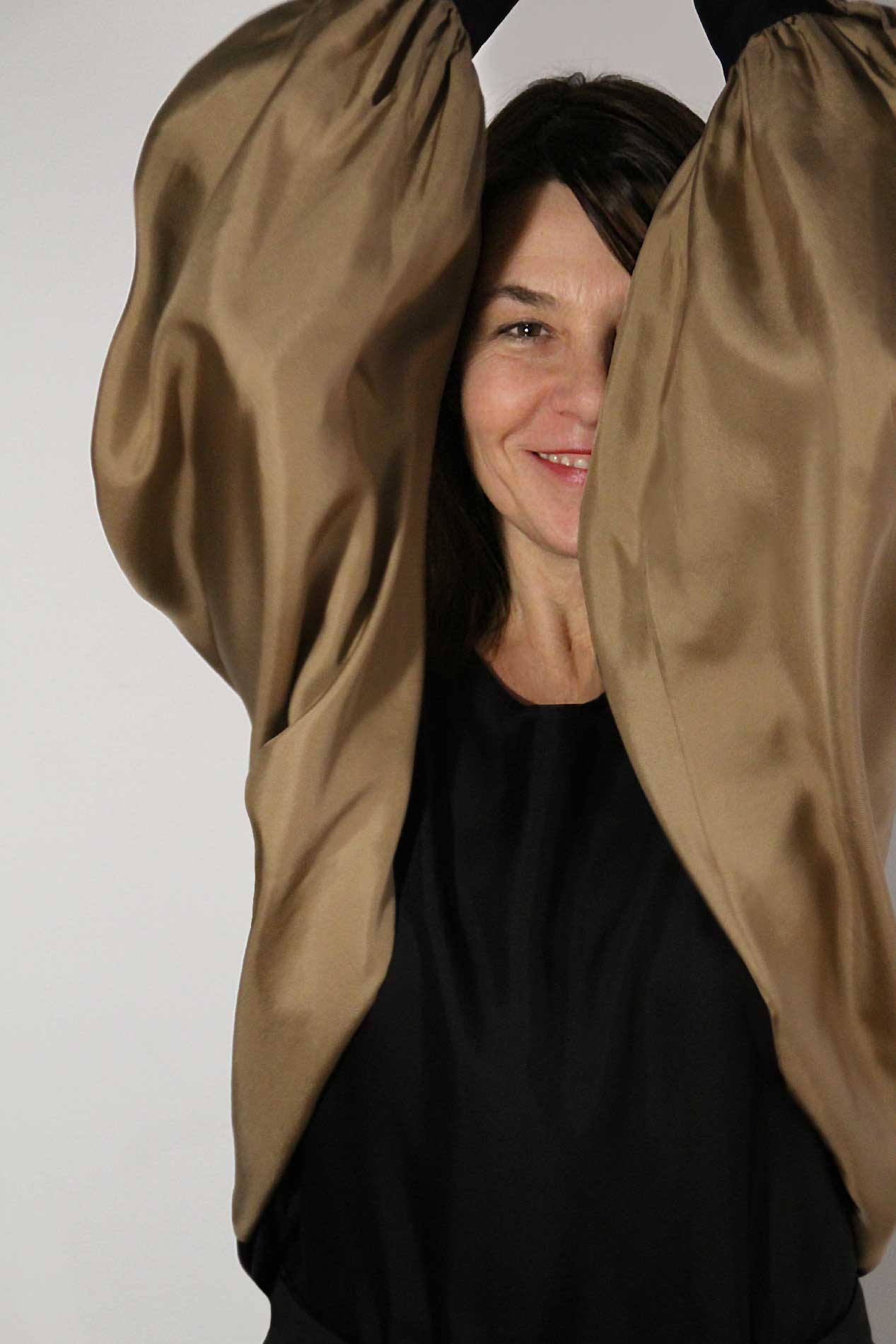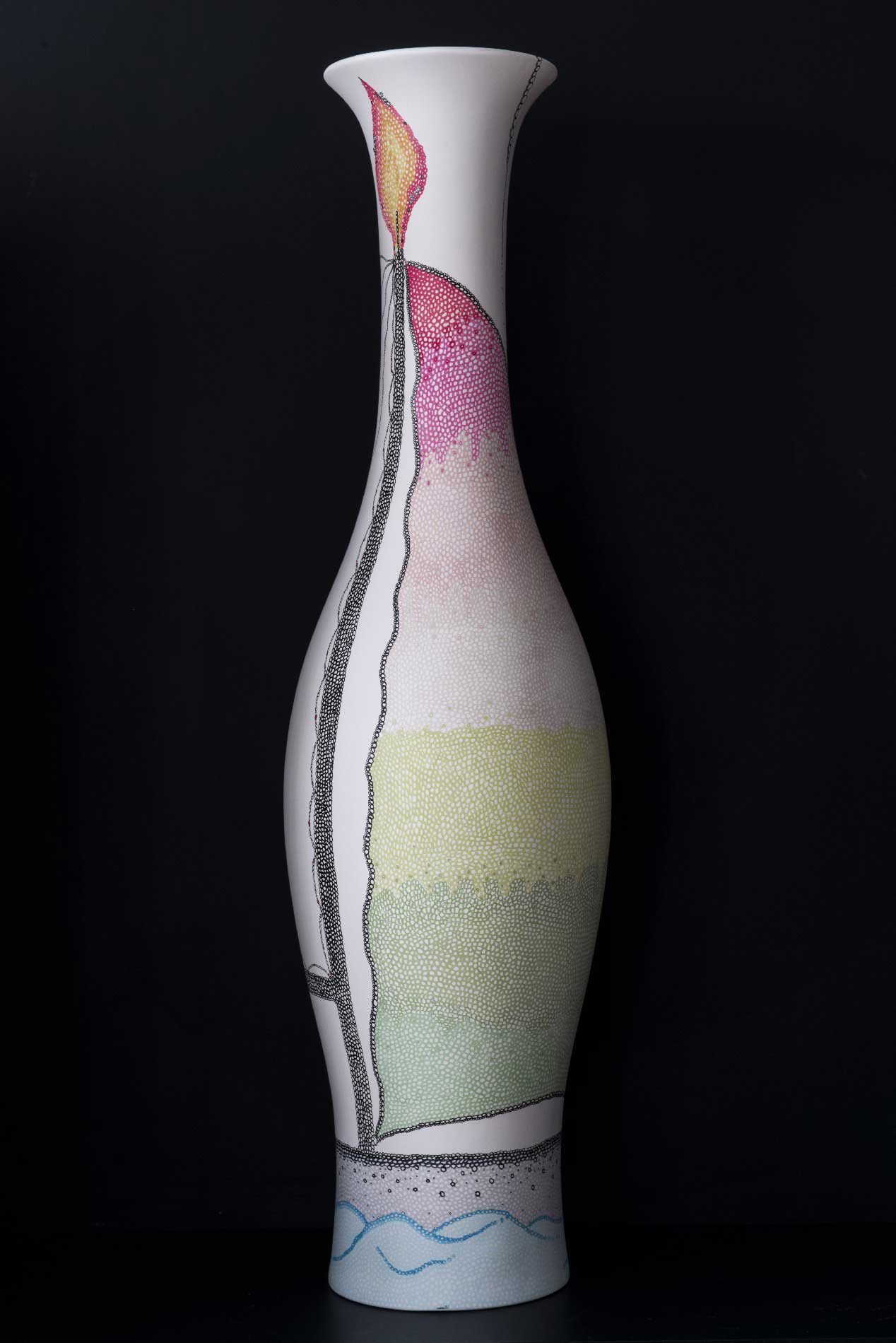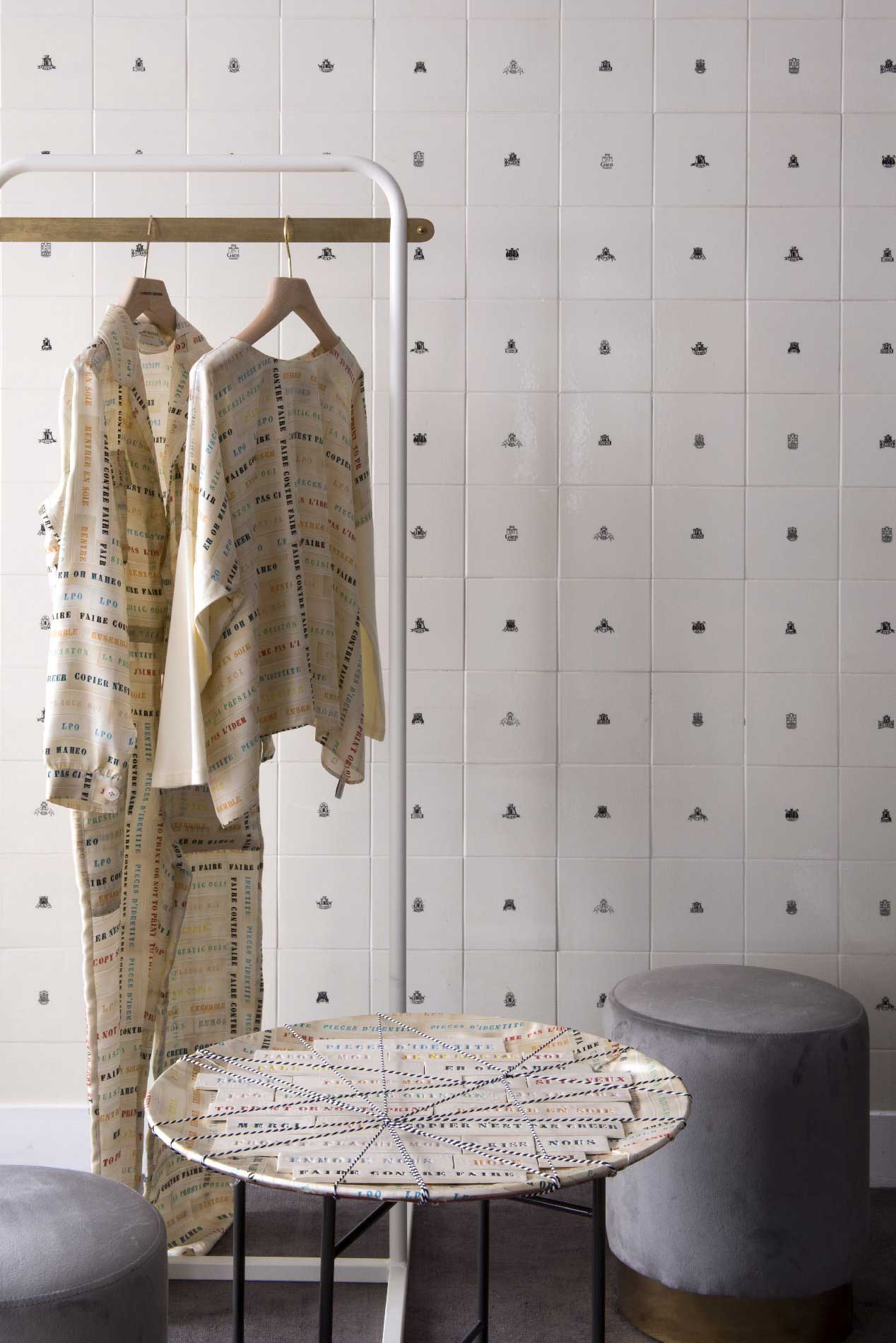La Prestic Ouiston
A trio for a carte blanche

Biographies
Laurence Mahéo founded La Prestic Ouiston almost twenty years ago, a fashion brand conveying values shared by many today : freedom, timelessness, durability, femininity. An art of living, a way of being, which is expressed chiefly in blouses, dresses, tops, trousers, … in silk, bringing grace without fragility, introducing daywear to color and flow.
She began by using scarves she’d hunted out, mixing them, crossing motifs and diverse colors. Then she approached other artists, women : Laurence Kiberlain, writer and illustrator, in 2008. Together, they conceive drawings like an invitation that takes us on a journey in all forms, sentimental, astral, with Breton detours. Laurence Kiberlain does not draw in straight lines or flowing curves, but has a partiality for round shapes, big and small. They depict figures, objects, shapes and faces.
Stéphanie Bonvicini, sculptress, also comes on board to join Laurence Mahéo who is constantly widening her horizons. Horizons of creation, as she embarks on new adventures. Laurence Mahéo starts up her own publishing business, publishes her first two books and also brings out Stephanie Bonvicini’s “words in ceramic”, imprinted in clay like the origins of writing. A very poetic trio, in silk, in words and drawings.
Q&A with Laurence Maheo
WHY DID YOU ACCEPT THIS CARTE BLANCHE WITH FAÏENCERIE DE GIEN
FOR ITS BICENTENARY ?
It offered me a new artistic opportunity, unprecedented withthis distinguished earthenware maker.
WHAT INSPIRATIONS HAVE YOU DRAWN ON FOR THIS VENTURE ?
Childhood memories on the beach, my sea shell collections, and a wonderfully simple gravestone at the Saint Tropez marine graveyard.
HOW DID YOU APPROACH THE TECHNICAL CHALLENGE OFEARTHENWARE AND FAÏENCERIE KNOW-HOW ?
JI let myself go with the flow. I focussed instinctively on painting, drawing, collage, combinations, while constantly trying to avoid being daunted by the superlative skill of the Faïencerie de Gien, otherwise I wouldn’t have made it!
WHILST YOU WERE WORKING ON THIS CARTE BLANCHE, HOW DID THE
WORLD OF DECORATION AND TABLEWARE RESONATE WITH YOUR OWN
WORLD ?
The transmission of know-how is something I find very exciting. I also find it
thrilling to be able to share my rather organic world with the more classic and corporate story of Gien.
WHAT HAS STAYED WITH YOU THE MOST, OF THIS EXPERIENCE ?
The wish to do it all over again ! And I intend to do so ...


Q&A with Laurence Kiberlain
WHY DID YOU ACCEPT THIS CARTE BLANCHE WITH FAÏENCERIE DE GIEN
FOR ITS BICENTENARY ?
I first heard of this project through Laurence Mahéo. She and I have been working together for nearly 10 years now on creating illustrations. As soon as she told me, I was immediately taken by the idea. When I work on a project with Laurence I usually draw along the lines of the themes she chooses for each season. I also create collages and drawings from inspiration that comes to me on a personal level, directly through my feelings and my state of mind with regard to my experiences. In this instance, there is no set theme, we have been given Carte Blanche. After visiting the magnificent Gien showroom my first thought was that it would be fascinating to create a link between the world of Laurence Mahéo and her brand La Prestic Ouiston, my world, and the world of Gien. I saw that it would be interesting to use an amphora in the same way as a blank page of a book, which could serve, for Laurence and I, to “write what affects us”.
WHAT INSPIRATIONS HAVE YOU DRAWN ON FOR THIS VENTURE ?
What we are doing is marking a 200th birthday, and birthdays are a reminder of our childhood, and for Laurence and me, childhood is connected to sailing, boats, journeys. I sensed that celebrating the 200th anniversary of a prestigious house like Gien had something about it that felt like a real journey through time. So the drawings I have made and key words I have written are an expression of the memories we share, Laurence and I.
HOW DID YOU APPROACH THE TECHNICAL CHALLENGE OFEARTHENWARE AND FAÏENCERIE KNOW-HOW ?
When I visited the showroom I was concerned about how I would be able
to draw directly on earthenware. I normally use felt tip and ink, and I didn’t
know how I would get on. When the people at the Faïencerie de Gien sent me earthenware samples for me to draw on, I tried with felt tips and it worked, it worked really well. Drawing on this material has turned out to be a fantastic experience, a tremendous pleasure, like drawing on the softest of paper.
WHILST YOU WERE WORKING ON THIS CARTE BLANCHE, HOW DID THE
WORLD OF DECORATION AND TABLEWARE RESONATE WITH YOUR OWN
WORLD ?
For me, the world of tableware is synonymous with simplicity, white, I like the table setting to be neutral. When I buy patterned tableware, it is to set off my white pieces. I like the pattern to tell a story, which can be themed on nature, wildlife, abstract or graphic, it has to resonate with me and how I feel, like a work of art, a painting or a photo.
WHAT HAS STAYED WITH YOU THE MOST, OF THIS EXPERIENCE ?
This has been a thoroughly enjoyable experience for me, it has opened up a new sphere to me that I was familiar with but that I had never thought to explore further. Now I would love to continue to draw on earthenware, to design a pattern that would play a part in people’s pleasure in their homes, at their table, at times of joy and sharing, at parties, birthdays, romantic dinners. I would like to design tableware that could make these moments special and bring pleasure into people’s homes …
Q&A with Stéphanie Bonvicini
WHY DID YOU ACCEPT THIS CARTE BLANCHE WITH FAÏENCERIE DE GIEN
FOR ITS BICENTENARY ?
Who could refuse an offer to celebrate the bicentenary of a House of Art that is an integral part of France’s living heritage? A House that through its work and development, relates the magnificent history of the 20th century? For an art lover and patriot like me, and a ceramist to boot, an artistic project of this nature giving me total freedom, was a gift.
WHAT INSPIRATIONS HAVE YOU DRAWN ON FOR THIS VENTURE ?
My inspiration came from my desire to pay a tribute. I wanted to celebrate,
in my modest way, the work of Christo, whom I admire, and whose final performance was the Arc de Triomphe, wrapped, in the same year as the Faïencerie’s bicentenary. Christo was a great artist as well as an outstanding
craftsman of exceptional technical ability. He wrapped remarkable places and objects, he “dressed” them. For a Carte Blanche with a fashion house, all I did was pull on a piece of thread.
HOW DID YOU APPROACH THE TECHNICAL CHALLENGE OFEARTHENWARE AND FAÏENCERIE KNOW-HOW ?
Being a ceramist, I am used to working with earthenware, but handling such perfect quality biscuit had a wonderfully stirring effect on me. I felt the urge to cover the heavy platter with a silk as soft as its smooth surface, to follow its shapely curves and bring airiness and delicacy. I then added my word plaques to bring brightness, as do all the glazed pieces at the Manufacture.
WHILST YOU WERE WORKING ON THIS CARTE BLANCHE, HOW DID THE
WORLD OF DECORATION AND TABLEWARE RESONATE WITH YOUR OWN
WORLD ?
Resonate? To start with, like a sound! My earthenware word plaques make the same sound together as a pile of plates! I love the strength of earthenware, the brightness of its glaze and the sound of pieces clinking together. Be they vintage dinner services or more modern pieces, I love the
sound they make. It sends a message of fragility too. And few things remind
me so clearly of childhood, of passing down, of family, refinement, sharing.
To me these values are meaningful and comforting. And the place where they are all brought together is the table.
WHAT HAS STAYED WITH YOU THE MOST, OF THIS EXPERIENCE ?
I was very pleased to be chosen by La Prestic Ouiston to produce a piece of work in the context of the Faïencerie de Gien’s bicentenary. More than pleased, honored. I have huge respect for these companies that make such a valuable contribution to the greatness of France. And it has made me aware for the first time of how much the world of Fashion and the world of luxury tableware have in common. Because, the art of tableware is in reality the art of dressing a table. These two worlds are drawn together in elegance. Elegance, now there’s a tale to tell that is so very French ...

